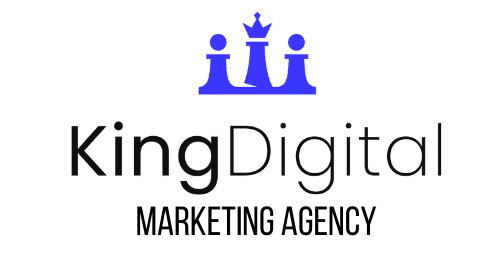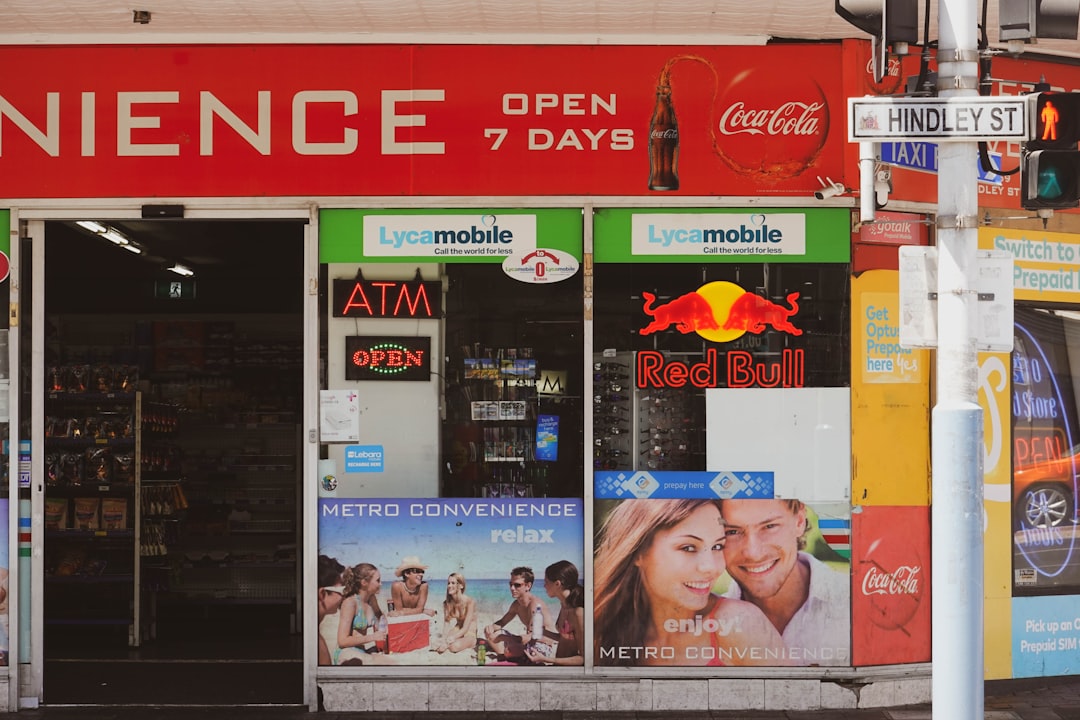Local PPC advertising: Drive Growth 2025
Why Local Businesses Are Turning to Paid Ads
Local PPC advertising is a digital marketing strategy that shows paid ads to customers in a specific geographic area, such as your city, neighborhood, or a radius around your business. Unlike traditional advertising, local PPC targets people actively searching for your products or services nearby, driving foot traffic and calls from customers who are ready to buy. This approach offers immediate visibility at the top of search results, reaching high-intent customers on a pay-per-click basis where you can track every result.
With nearly 90% of customers using search engines to find local businesses, being visible is critical. When someone searches for “plumber near me” or “coffee shop downtown,” local PPC places your business front and center. While traditional SEO can take months to yield results, local PPC ads deliver immediate visibility on Google search and Google Maps. Think with Google reports that 76% of people who search for something nearby on their smartphone visit a related business within a day, underscoring how powerful local intent can be for storefronts and service providers alike (source: https://www.thinkwithgoogle.com/consumer-insights/consumer-trends/how-digital-connects-shoppers-to-local-stores/).
I’m Bernadette King, and at King Digital, I’ve helped countless small businesses use Local PPC advertising to turn online visibility into real-world sales. My experience has shown me what it takes to convert local searchers into paying customers. Local PPC connects you with customers at the moment they decide to act, whether that’s calling for a quote, getting directions, or booking an appointment. For any business dependent on local clientele, this strategy delivers measurable results in hours, not months. For background on how Google Ads matches searchers to nearby businesses, see Google’s overview of location targeting (https://support.google.com/google-ads/answer/2453995).
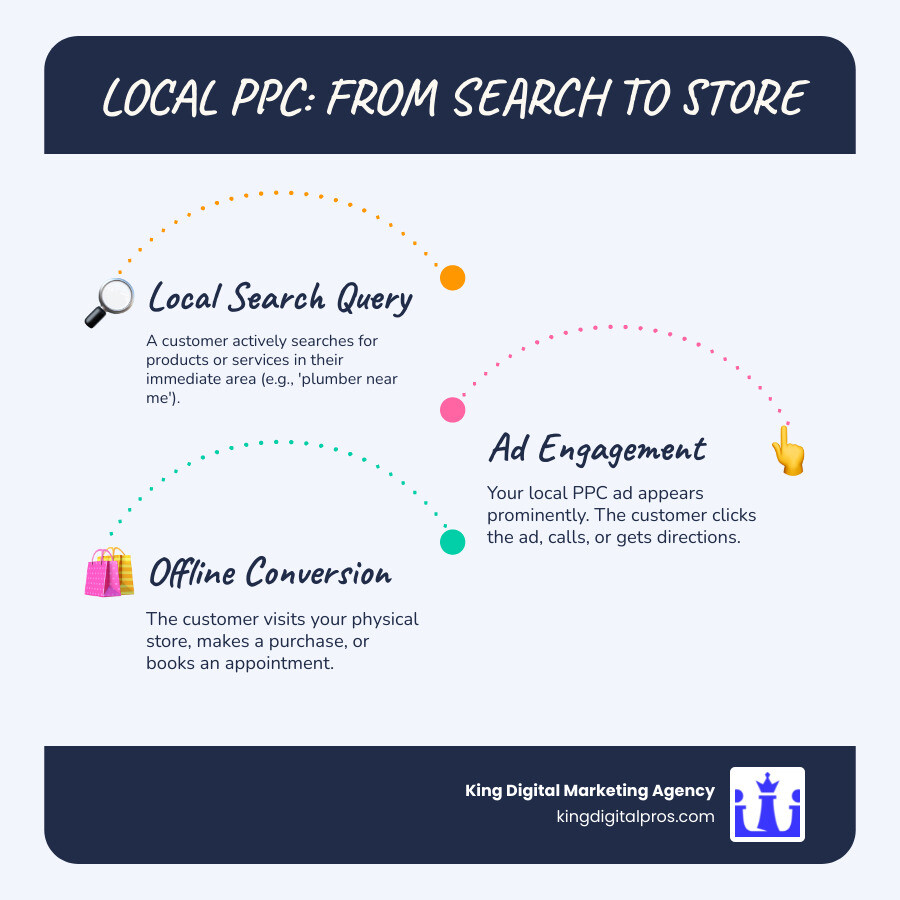
Infographic: How a nearby search leads to a click, a call or directions, and a visit – with measurable conversion points at each step.
Foundations of Local PPC: Reaching Customers Around the Corner
Local PPC advertising meets customers where they are, blending technology and strategy to target your ideal audience with precision. The key difference from traditional PPC is geography. While broad PPC campaigns target entire countries, local PPC narrows the focus to a specific city, neighborhood, or radius around your business. This ensures your ad spend reaches people who can actually become customers.
The bidding process is similar to traditional PPC, but with a local advantage: your proximity to the searcher is a major factor. If someone is two blocks from your cafe, you have an edge over a competitor across town, even with a lower bid. Your ads appear not only at the top of search results but also in the Google Map Pack and within the Google Maps app itself. When someone searches for “dentist near me,” your business can appear on their map with directions, your phone number, and reviews.
Here’s a quick comparison:
| Feature | Traditional PPC | Local PPC |
|---|---|---|
| Audience | Broad (national/international) | Specific Geography (city, neighborhood, radius) |
| Keywords | General, high-volume | Localized, intent-driven, “near me” |
| Goal | Brand awareness, online sales | Immediate conversions, foot traffic, calls |
| Competition | High, broad market | High, local market |
| Ad Placement | SERP (top), display network | SERP (top), Map Pack, Google Maps |
| Value Proposition | Reach, scale | Relevance, urgency, local conversions |
Understanding the Core Components of Local PPC Advertising
To succeed with Local PPC advertising, you must master its core components.
Location targeting is the foundation. You can show ads in specific cities, states, or a custom radius. For instance, a Rio Rancho business could target a ten-mile radius. A critical setting is choosing the “Presence” option in Google Ads, which targets people currently in your area, avoiding wasted spend on those who have moved or are just planning a trip.
Radius targeting offers even more control, letting you draw a virtual circle around your business or layer multiple zip codes to match your service area perfectly.
Location-based keywords are phrases people use for local help, like “emergency plumber Santa Fe” instead of just “plumber.” These keywords signal local intent and are crucial for connecting with ready-to-act customers.
Ad extensions make your ads stand out and provide direct conversion paths. Location extensions show your address and map marker. Call extensions allow mobile users to call you with a single tap. Sitelink extensions link to specific pages like your menu or contact form, and Promotion extensions highlight special offers. Our PPC Management service handles this entire setup for you.
The bidding process and Quality Score determine your ad’s position and cost. Google runs an auction for every search, considering your bid and your Quality Score, which measures the relevance of your ad, keywords, and landing page. A higher Quality Score leads to lower costs and better ad positions. According to WordStream’s research on Quality Score, improving your score can significantly reduce your cost-per-click.
Why Local PPC Beats Traditional SEO for Speed
While SEO provides long-term value, it’s a marathon that can take six months or more to show results. If you want to learn more about building this foundation, check out our guide on how to improve search ranking.
Local PPC advertising offers a shortcut to the top. Your ads can appear in search results within hours of launching a campaign, providing invaluable visibility when you need leads immediately. Organic results are also limited, with only a few businesses making it to the first page or into the Google Map Pack. Local PPC allows you to secure prime positioning without the long wait, capturing demand while competitors are still climbing the organic ranks. The best strategy uses both: local PPC for immediate revenue and SEO for long-term, sustainable growth.
The Key Benefits: Why Your Business Needs Local PPC
For a local business, every marketing dollar counts. Local PPC advertising is a strategic tool that connects you with customers who are actively looking for your services, right when they need them. Its precision allows you to invest in reaching the right people at the right time, rather than casting a wide, expensive net.
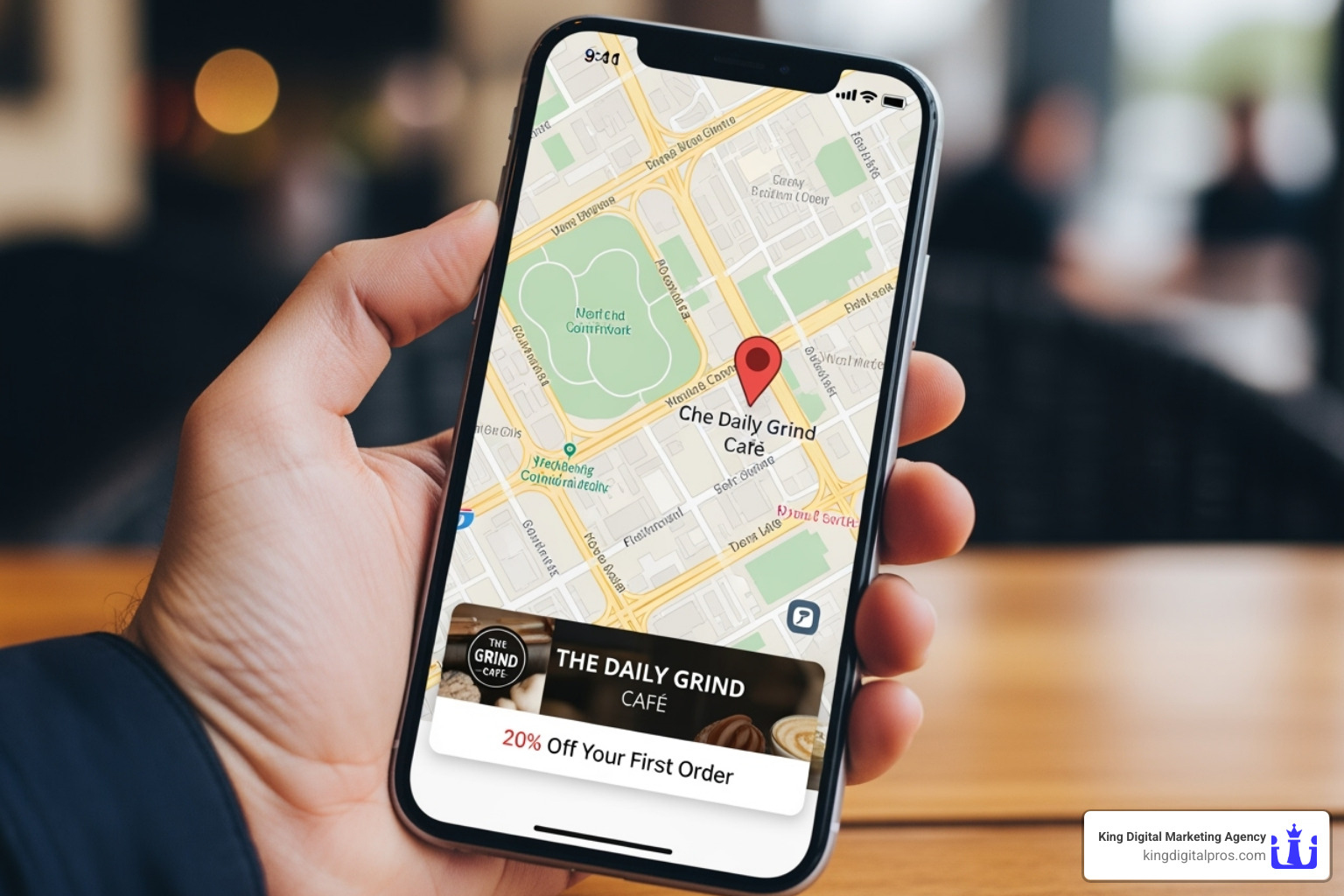
Driving High-Intent Traffic and Footfall
People clicking on Local PPC advertising ads are not just browsing; they are searching with purpose. A search for “plumber near me” or “best tacos in Albuquerque” signals an immediate need. This high-intent traffic is marketing gold, as these searchers are already on the path to becoming a customer.
For businesses with physical locations, local PPC excels at driving foot traffic. When your ad appears in the Google Map Pack with your address and a “Get Directions” button, you make it incredibly easy for nearby customers to find you. According to Brightlocal statistics, 87% of people use Google to find local business information, and your ad can bridge their research to your front door. We help businesses create these connections, and you can learn more about our approach to attracting customers.
Many local searches also result in immediate phone calls, especially for service-based businesses. Local PPC ads with call extensions make this effortless, turning a search into a conversation in seconds.
Gaining Quick, Measurable Results and Insights
Unlike traditional advertising, Local PPC advertising provides concrete data on every dollar spent. From the moment your campaigns go live, you can see how many people clicked your ad, their location, the device they used, and their actions on your site. This is specific, actionable intelligence.
This real-time data means you’re never flying blind. You can quickly identify which keywords are converting, which neighborhoods are most responsive, and which ad copy resonates with your audience. This tracking extends beyond clicks to include phone calls, direction requests, and even foot traffic to your store. You get a complete picture of how ads translate into real-world action. Google’s economic impact data shows that businesses typically see a strong return on their ad spend, making the ROI both measurable and substantial.
The insights gained can inform your broader business strategy, from staffing to inventory. We help clients interpret this data through our lead tracking services, turning numbers into growth strategies. This combination of immediate results and detailed insights allows you to learn and improve with every campaign.
Building Your Winning Local PPC Advertising Strategy
A successful Local PPC advertising campaign requires a clear plan. Before launching, you must define your goals-more phone calls, foot traffic, or appointments-and understand your target audience’s behaviors and pain points. While Google Ads is the primary platform for local search, other platforms like Microsoft Advertising or Meta Ads can also be effective depending on where your customers spend their time.
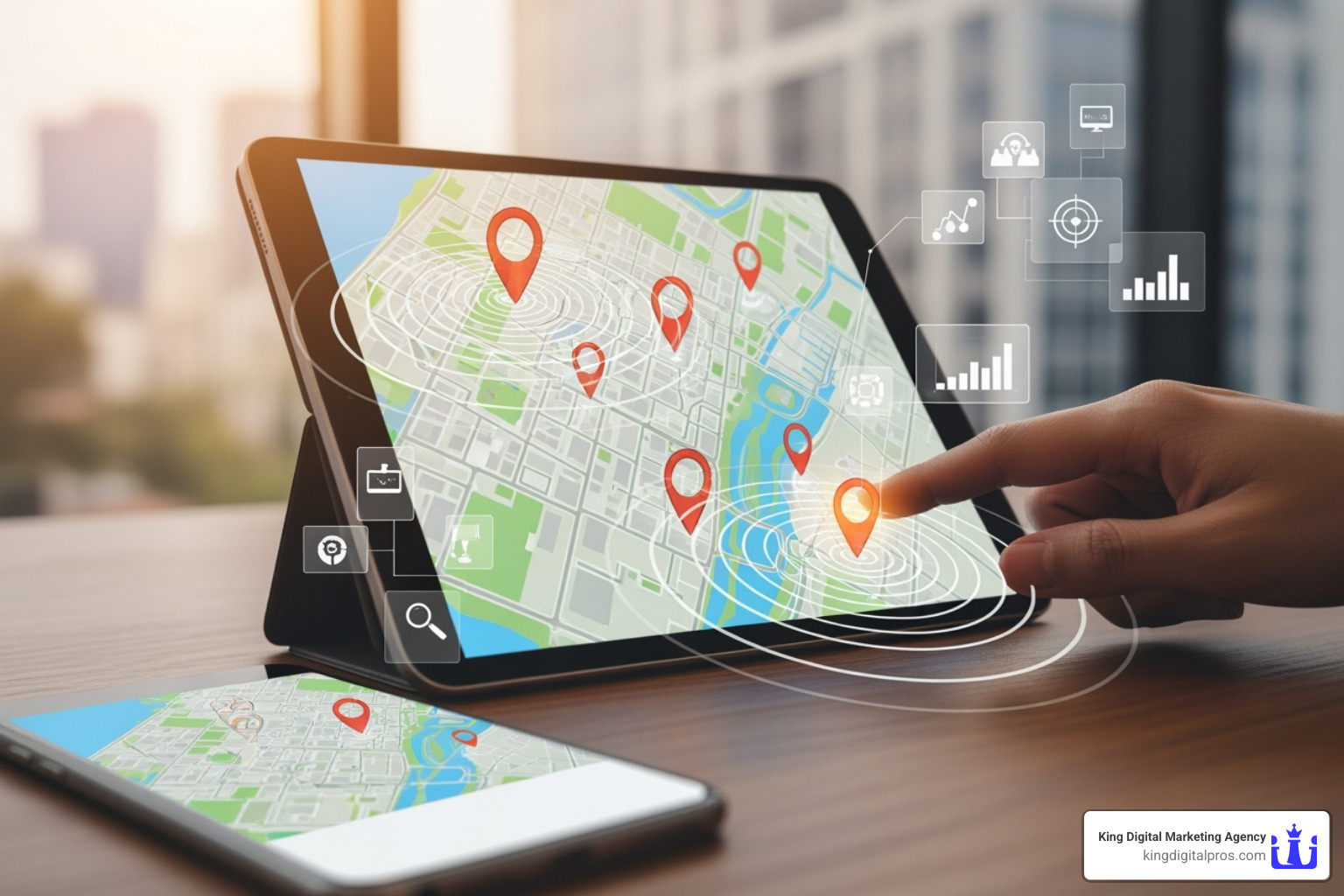
Step 1: Local Keyword Research and Selection
Connecting with local customers starts with understanding how they search. Think from their perspective: what phrases would they use? Often, it’s a combination of a service and a location, such as “plumber Albuquerque” or “coffee shop Nob Hill”.
The Google Keyword Planner is an essential tool for this research. It reveals search volumes, estimated costs, and suggests related keywords. Longer, more specific phrases (long-tail keywords) often perform best. According to research from Ahrefs, these phrases make up a majority of searches. Someone searching for “emergency plumber available now Tijeras NM” has high intent and is ready to hire. These keywords face less competition and convert at higher rates. For more strategies, see our guide on local SEO keyword research.
Step 2: Crafting Compelling Local Ad Copy and Landing Pages
Your ad has only a few lines to convince a searcher to click. Effective ads include target keywords in the headline, a reassuring URL, copy that communicates your unique value, and a clear call to action (CTA) like “Call Now” or “Get Directions.” We recommend A/B testing at least two ad versions to see what resonates with your audience. Our copywriting services can help craft messages that connect with local customers.
The landing page experience is just as important. If your ad promises emergency plumbing in Albuquerque, the landing page must be about that specific service and location, not your generic homepage. This relevance is crucial for conversions and your Quality Score. For businesses with multiple service areas, dedicated local landing pages are highly effective.
Mobile optimization is mandatory, as over half of all searches happen on phones. Your pages must load quickly and be easy to steer on a small screen. A slow or clunky mobile experience will cause users to leave and may prevent them from ever returning. We specialize in improving conversion rates through better design; learn more on our conversion optimization page.
Step 3: Budgeting and Tracking ROI for Local PPC Advertising
Strategic budgeting and careful tracking are key to a positive return on investment (ROI) from Local PPC advertising. Cost-per-click (CPC) varies by industry and location, but a higher CPC can be worthwhile if it leads to a high-value customer.
Google determines your actual cost based on your bid, Quality Score, and competitor performance. A higher Quality Score lowers your costs, rewarding you for relevance. When starting, aim for a budget that allows for at least 100 clicks per month to give the algorithm enough data to optimize.
Understanding the math behind your campaigns is vital. If a customer is worth $500 and it takes 10 leads to get one customer, each lead is worth $50. This helps you set a maximum CPC that ensures profitability. On average, businesses earn $2 for every $1 spent on Google Ads, but your specific results depend on tracking. Monitor clicks, calls, form submissions, and sales to understand your true ROI. Use our marketing ROI calculator to project potential returns.
Optimizing Your Campaigns for Maximum Impact
Launching a Local PPC advertising campaign is only the first step; continuous optimization is where you achieve maximum impact. PPC campaigns require constant refinement based on performance data. By A/B testing different ad copy, keywords, and targeting settings, you can find what truly resonates with your local audience and improve results over time. Using tools like Google Analytics to monitor campaigns allows you to make data-driven decisions, such as adjusting bids, pausing underperforming ads, and scaling up what works.

Leveraging Ad Extensions and Mobile Optimization
Ad extensions make your ads larger, more informative, and more effective. Location extensions display your address and provide a link to directions, making it easy for customers to find you. Call extensions allow mobile users to call you directly from the ad, which is perfect for capturing high-intent searchers. Other useful extensions include sitelinks (linking to specific site pages), structured snippets (highlighting services), and promotions (announcing sales). These not only help customers but also tend to boost your click-through rate and Quality Score, often leading to a lower cost-per-click.
Mobile optimization is critical. With most searches happening on mobile devices, your landing pages must be fast and user-friendly. According to research from Google, over half of mobile users will abandon a site that takes more than three seconds to load. A poor mobile experience can cost you a conversion and damage your brand’s reputation. Prioritize a seamless mobile experience, from ad click to conversion. For help creating a responsive, fast-loading site, explore our SEO friendly website design services.
Integrating with Your Google Business Profile
Your Google Business Profile (GBP) is your digital storefront, and integrating it with your Local PPC advertising campaigns is essential. Ad platforms pull data directly from your GBP, so ensure your hours, phone number, and address are always accurate to avoid wasted ad spend.
When you connect your GBP to Google Ads, your star ratings and customer reviews can appear in your ads, building instant trust. The integration also ensures your business hours are accurately displayed and makes map directions seamlessly available. A well-optimized and connected GBP increases your chances of appearing in the coveted Google Map Pack, which is prime real estate for local businesses. Keep your profile active by updating information, responding to reviews, and encouraging new ones. Learn more about how we manage this on our Google Profile Management page.
Using Negative Keywords to Eliminate Wasted Spend
Negative keywords are a powerful tool in your Local PPC advertising arsenal. These are terms you tell the ad platform not to show your ads for, which helps eliminate wasted spend on irrelevant clicks.
For example, a high-end furniture store in Grants, NM, would add “cheap” and “free” as negative keywords. It’s also crucial to exclude other cities and regions you don’t serve. If you only operate in Grants, add “Albuquerque” and “Santa Fe” as negatives. Also, filter out irrelevant intent keywords like “jobs,” “DIY,” or “how to,” which signal informational searches rather than buying intent.
Regularly review your search term reports in Google Ads to find new negative keywords to add. This ongoing refinement focuses your budget on the most relevant, high-intent clicks and is one of the most effective ways to improve ROI. For more tips on eliminating waste, see our PPC management guide.
Conclusion: Put Your Business on the Local Map
Local PPC advertising is more than a marketing expense; it’s a direct investment in immediate growth. While other strategies take months to build momentum, local PPC puts your business in front of customers the moment they are ready to buy. It connects your services with high-intent local searchers, turning clicks into calls and foot traffic in real-time.
The true power of local PPC lies in its measurability. Every dollar is trackable, allowing you to see exactly what’s working. By continuously testing ads, refining keywords, and using negative keywords to eliminate waste, you create a marketing engine that becomes more efficient over time. We’ve seen businesses transform when they accept this strategy, turning quiet hours into peak times and word-of-mouth referrals into a flood of new leads. According to WordStream’s research on Google Ads benchmarks, optimized campaigns consistently deliver strong returns.
Effective PPC management requires expertise and constant attention. At King Digital Marketing Agency, we specialize in turning local searches into real-world business growth. We handle every detail, from keyword research to conversion tracking, so you can focus on what you do best: serving your customers.
Ready to stop waiting for customers to find you? Let’s put your business on the map. Get your custom PPC strategy today and turn local searches into your next loyal customers.
